
The Harrier is a medium-sized dog breed of the hound class, used for hunting hares by trailing them. It resembles an English Foxhound but is slightly smaller, though not as small as a Beagle. The breed has been used since the mid 13th century.

A hound is a type of hunting dog used by hunters to track or chase prey.

Scent hounds are a type of hound that primarily hunts by scent rather than sight. These breeds are hunting dogs and are generally regarded as having some of the most sensitive noses among dogs. Scent hounds specialize in following scent or smells. Most of them tend to have long, drooping ears and large nasal cavities to enhance smell sensitivity. They need to have relatively high endurance to be able to keep track of scent over long distances and rough terrain. It is believed that they were first bred by the Celts by crossbreeding mastiff-type dogs with sighthounds. The first established scent hounds were St. Hubert Hounds bred by monks in Belgium during the Middle Ages.

The Black and Tan Coonhound is a breed of hunting dog. Developed in the United States from crosses between the Bloodhound and the Black and Tan Virginia Foxhound, this scent hound runs its game entirely by scent and is used primarily for raccoon hunting.

The Bluetick Coonhound is a breed of coonhound originating in the United States. The Bluetick Coonhound is known for its friendly personality, cold nose, and deep bawl mouth. It is most commonly used as a raccoon hunting dog, but is also kept as a pet.

The United Kennel Club (UKC) is a kennel club founded in 1898 in the United States. In contrast with the American Kennel Club, which is non-profit and which only clubs can join, the United Kennel Club is a profit-making corporation, open to individuals.

The American Foxhound is a breed of dog, closely related to the English Foxhound. They are scent hounds, bred to hunt foxes by scent. United States Founding Father George Washington was key to the breed's early development.
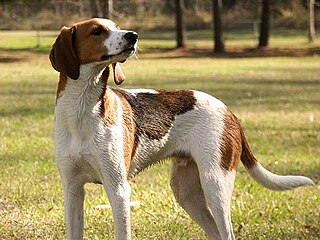
The Treeing Walker Coonhound is a breed of hound descended from the English and American Foxhounds. The breed originated in the United States when a stolen dog known as "Tennessee Lead" was crossed into the Walker Hound in the 19th century. The Treeing Walker Coonhound was recognized officially as a breed by the United Kennel Club in 1945 and by the American Kennel Club in 2012.
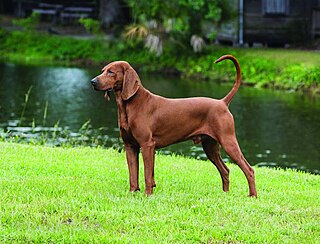
The Redbone Coonhound is an American breed of hunting dog. As a coonhound, the Redbone is primarily a hunter of small game that hide in trees, such as raccoons, opossums, and squirrels, but is also capable of handling big game like bears and cougars. Its hunting strategy is to tree wild game where hunters can then shoot the target, rather than directly hunting and subduing the prey.

The Plott Hound is a large scent hound, originally bred for hunting bears. In 1989, the North Carolina General Assembly designated the Plott Hound as the official State Dog. The Plott Hound was first registered with the United Kennel Club in 1946. Plott Hounds were recognized by the American Kennel Club in 2006 and were exhibited at the Westminster Show in 2008.

The Barak or Bosnian Broken-haired Hound, is a hunting dog breed developed in Bosnia. The breed is a scenthound, originally used to hunt large game. Other names include Bosnian Rough-haired Hound and Bosnian Rough-coated Hound. These names refer to the texture of the shaggy coat, usually called broken-haired or hard in English dog fancier jargon.

The Drever is a breed of dog, a short-legged scenthound from Sweden used for hunting deer and other game. The Drever is descended from the Westphalian Dachsbracke, a type of German hound called Bracke. The breed name Drever was chosen through a contest in 1947.
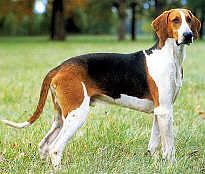
The Anglo-Français de Petite Vénerie is a medium-sized breed of dog used in hunting as a scenthound, usually in packs. It is one of the Anglo-French hound breeds which were created by crossing French scenthounds with English foxhounds. The name Petite Vénerie does not mean that dogs of the breed are petite or small, but rather that it is used to hunt small game.
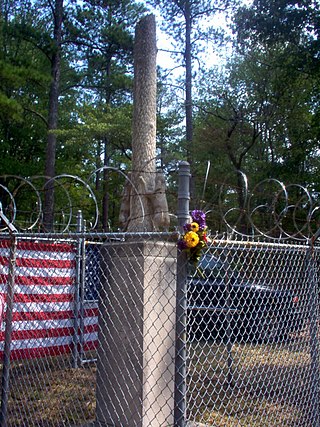
The Key Underwood Coon Dog Memorial Graveyard is a specialized and restricted pet cemetery and memorial in rural Colbert County, Alabama, US. It is reserved specifically for the burials of coon dogs. The cemetery was established by Key Underwood on September 4, 1937. Underwood buried his own dog there, choosing the spot, previously a popular hunting camp where "Troop" did 15 years of service. As of August 2014, more than 300 dogs were buried in the graveyard.
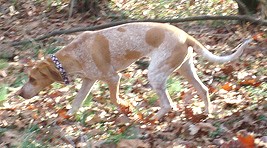
The American English Coonhound, also referred to as the English Coonhound or the Redtick Coonhound, is a breed of coonhound that originated in and is typically bred in the Southern United States. It is descended from hunting hounds, especially foxhounds, brought to America by settlers during the 17th and 18th centuries. The breed's first recognition came from the United Kennel Club in 1905 as the English Fox and Coonhound. Further recognition has been granted in recent years by the American Kennel Club, first in the Foundation Stock Service and in 2011 as a fully recognized member of the hound group.

The American Leopard Hound is an American breed of hunting dog. It is recognized by the United Kennel Club (UKC) as a scenthound and is in the American Kennel Club's Foundation Stock Service.

The Grand Anglo-Français Blanc et Orange translated into English as the Great Anglo-French White and Orange Hound, is a breed of dog used in hunting as a scenthound, usually in packs. It is one of the Anglo-French hound breeds which were created by crossing French scenthounds with English (Anglo) foxhounds.

The Rastreador Brasileiro is a large breed of dog from Brazil, first recognised by the Fédération Cynologique Internationale in 1967, but an outbreak of disease, compounded by an overdose of insecticide, wiped out the breed's entire breeding stock. The FCI and the Brazilian Kennel Club then declared the breed extinct in 1973 and delisted it. Since then, efforts have been made to re-create the breed. The Rastreador Brasileiro is a hunting dog of the scenthound type. The breed is also known by the names Urrador or Urrador Americano, in reference to the American (U.S.) coonhounds in its background. In 2013, the Brazilian Kennel Club (CBKC) officially re-recognized the breed. The FCI Breed Standard was produced in 2019.

Coon hunting is the practice of hunting raccoons, most often for their meat and fur. It is almost always done with specially bred dogs called coonhounds, of which there are six breeds, and is most commonly associated with rural life in the Southern United States. Coon hunting is also popular in the rural Midwest. Most coon hunts take place at night, with the dogs being turned loose, trailing and putting the raccoon up a tree without human assistance. Once the raccoon is in the tree, with the dog at the base, it is referred to as "treed", with "treeing" being the active verb form.




















